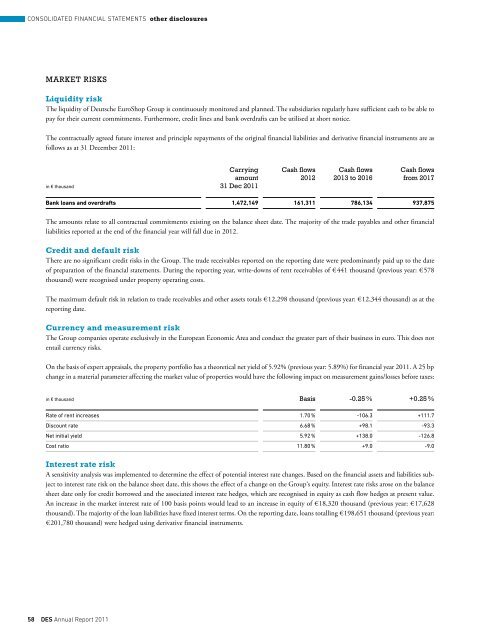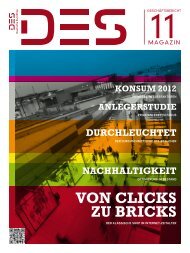Financials - Deutsche EuroShop
Financials - Deutsche EuroShop
Financials - Deutsche EuroShop
Create successful ePaper yourself
Turn your PDF publications into a flip-book with our unique Google optimized e-Paper software.
ConSoLIDAteD FInAnCIAL StAteMentS other disclosures<br />
MaRKET RISKS<br />
liquidity risk<br />
The liquidity of <strong>Deutsche</strong> <strong>EuroShop</strong> Group is continuously monitored and planned. The subsidiaries regularly have sufficient cash to be able to<br />
pay for their current commitments. Furthermore, credit lines and bank overdrafts can be utilised at short notice.<br />
The contractually agreed future interest and principle repayments of the original financial liabilities and derivative financial instruments are as<br />
follows as at 31 December 2011:<br />
in € thousand<br />
Carrying<br />
amount<br />
31 Dec 2011<br />
Cash flows<br />
2012<br />
Cash flows<br />
2013 to 2016<br />
Cash flows<br />
from 2017<br />
Bank loans and overdrafts 1,472,149 161,311 786,134 937,875<br />
The amounts relate to all contractual commitments existing on the balance sheet date. The majority of the trade payables and other financial<br />
liabilities reported at the end of the financial year will fall due in 2012.<br />
Credit and default risk<br />
There are no significant credit risks in the Group. The trade receivables reported on the reporting date were predominantly paid up to the date<br />
of preparation of the financial statements. During the reporting year, write-downs of rent receivables of € 441 thousand (previous year: € 578<br />
thousand) were recognised under property operating costs.<br />
The maximum default risk in relation to trade receivables and other assets totals € 12,298 thousand (previous year: € 12,344 thousand) as at the<br />
reporting date.<br />
Currency and measurement risk<br />
The Group companies operate exclusively in the European Economic Area and conduct the greater part of their business in euro. This does not<br />
entail currency risks.<br />
On the basis of expert appraisals, the property portfolio has a theoretical net yield of 5.92% (previous year: 5.89%) for financial year 2011. A 25 bp<br />
change in a material parameter affecting the market value of properties would have the following impact on measurement gains/losses before taxes:<br />
in € thousand Basis -0.25 % +0.25 %<br />
Rate of rent increases 1.70 % -106.3 +111.7<br />
Discount rate 6.68 % +98.1 -93.3<br />
Net initial yield 5.92 % +138.0 -126.8<br />
Cost ratio 11.80 % +9.0 -9.0<br />
interest rate risk<br />
A sensitivity analysis was implemented to determine the effect of potential interest rate changes. Based on the financial assets and liabilities subject<br />
to interest rate risk on the balance sheet date, this shows the effect of a change on the Group‘s equity. Interest rate risks arose on the balance<br />
sheet date only for credit borrowed and the associated interest rate hedges, which are recognised in equity as cash flow hedges at present value.<br />
An increase in the market interest rate of 100 basis points would lead to an increase in equity of € 18,320 thousand (previous year: € 17,628<br />
thousand). The majority of the loan liabilities have fixed interest terms. On the reporting date, loans totalling € 198,651 thousand (previous year:<br />
€ 201,780 thousand) were hedged using derivative financial instruments.<br />
58 Des Annual Report 2011





